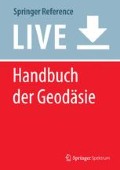Zusammenfassung
3D Darstellungen, Augmented-Reality-Visualisierungstechniken und fortgeschrittene Interaktionstechniken haben ein großes Potenzial, um die Interpretation von Geodaten zu unterstützen und die Interaktion mit raumbezogenen Daten zu vereinfachen. In diesem Kapitel wird dargestellt, wie diese Technologien die klassische Kartographie und Geovisualisierung ergänzen und welche Anwendungsmöglichkeiten sich daraus ergeben. Neben einer Beschreibung der technischen Grundlagen liegt der Schwerpunkt dabei auf der Integration der verschieden Technologieaspekte in das übergreifende Interaktionsparadigma der Augmented Reality.
Literatur
Azuma, R.T., Baillot, Y., Behringer, R., Feiner, S., Julier, S., MacIntyre, B.: Recent advances in augmented reality. IEEE Comput. Graph. Appl. 21(6), 34–47 (2001)
Azuma, R.T.: A survey of augmented reality. Presence: Teleoperators Virtual Environ 6(4), 355–385 (1997)
Cruz-Neira, C., Sandin, D., DeFanti, T.: Surround-screen projection-based virtual reality: The design and implementation of the CAVE. In: Proceedings of SIGGRAPH’93, S. 135–142. ACM, New York (1993)
Dörner, R., Broll, W., Grimm, P., Jung, B. (Hrsg.): Virtual und Augmented Reality (VR/AR), Grundlagen und Methoden der Virtuellen und Augmentierten Realität. Springer, Berlin/Heidelberg (2013)
Eggert, D., Hücker, D., Paelke, V.: „Augmented Reality Visualization of Archeological Data“, Cartography from Pole to Pole, Selected Contributions to the XXVIth International Conference of the ICA, S. 203–216. Springer, Berlin/New York (2014)
Epson Moverio: Produktwebseite. http://www.epson.de/de/de/viewcon/corporatesite/products/mainunits/overview/12411. (2015). Zugegriffen am 27.03.2015
Facebook: Pressemeldung „Facebook to Acquire Oculus“. http://newsroom.fb.com/news/2014/03/facebook-to-acquire-oculus/. (2014). Zugegriffen am 27.03.2015
Geng, W.: The Algorithms and principles of non-photorealistic graphics: Artistic Rendering and Cartoon Animation. Springer, Berlin/New York (2010)
Heeter, C.: Being there: The subjective experience of presence. Presence: Teleoperators Virtual Environ. 1(2), 262–271 (1992)
Hornecker, E.: A design theme for tangible interaction: embodied facilitation. In: Proceedings of 9th European Conference on Computer Supported Cooperative Work (E-CSCW’05), Paris, S. 23–43. Kluwer/Springer (2005)
Kahn, S.: Reducing the gap between Augmented Reality and 3D modeling with real-time depth imaging. Virtual Real. 17(2), 111–123. Springer, London (2013)
Kato, H., Billinghurst, M.: Marker tracking and HMD calibration for a video-based augmented reality conferencing system. In: Proceedings of 2nd International Workshop on Augmented Reality (IWAR’99), San Francisco, S. 85–94 (1999)
Ludwig, C., Reimann, C.: „Augmented Reality – Information im Fokus“, C-LAB Report, 4(1), 4–15 (2005). http://www.c-lab.de/de/services-downloads/c-lab-reports/index.html
Mekni, M., Lemieux, A.: Augmented reality: Applications, challenges and future trends. In: Proceedings of 13th International Conference on? Applied Computer and Applied Computational Science (ACACOS’14), Kuala Lumpur (2014)
Metaio: Produkt webseite. http://www.metaio.com. (2015). Zugegriffen am 27.03.2015
Microsoft Hololens: Hololens webseite. http://www.microsoft.com/microsoft-hololens/en-us. (2015). Zugegriffen am 27.03.2015
Milgram, P., Kishino, A.: Taxonomy of mixed reality visual displays. IEICE Trans. Inf. Syst. 1321–1329, Bd E77-D No.12 (1994)
Milgram, P., Takemura, H., Utsumi, A., Kishino, F.: Augmented reality: A class of displays on the reality-virtuality continuum. In: Telemanipulator and Telepresence Technologies, 2351, S. 282–292. SPIE, Bellingham (1995)
Oculus: Oculus VR webseite. https://www.oculus.com. (2015). Zugegriffen am 27.03.2015
Paelke, V.: Augmented reality in the smart factory: Supporting workers in an industry 4.0. environment. In: Proceedings 2014 IEEE Emerging Technology and Factory Automation, ETFA 2014, Barcelona, S. 1–4 (2014)
Paelke, V., Filin, S., Eggert, D., Barnea, S.: Adaptive LIDAR scanning of historic buildings supported by augmented reality user interfaces. In: Proceedings of EuroMed 2010, Nicosia, S. 65–72 (2010)
Paelke, V., Nebe, K., Geiger, C., Klompmaker, F., Fischer, H.: Designing multi-modal map-based interfaces for disaster management. In: Proceedings of ACHI 2012, Valencia, S. 95–100 (2012)
Qualcomm: Vuforia webseite. https://developer.qualcomm.com/mobile-development/add-advanced-features/augmented-reality-vuforia. (2015). Zugegriffen am 27.03.2015
Shaer, O., Hornecker, E.: Tangible user interfaces: Past, present, and future directions. In: Foundations and Trends in Human-Computer Interaction, 3(1), S. 1–137. Now Publishers, Hanover (2010)
Slay, H., Thomas, B., Vernik, R.: Tangible user interaction using augmented reality. Aust. Comput. Sci. Commun. 24(4), 13–20 (2002)
Ullmer, B., Ishii, H.: Emerging frameworks for tangible user interfaces. In: Carroll, J.M. (Hrsg.) HCI in the New Millenium, S. 579–601. Addison-Wesley (2001)
Welch, G., Foxlin, E.: Motion tracking: no silver bullet, but a respectable Arsenal. IEEE Comput. Graph. Appl. 22(6), 24–38 (2002)
Author information
Authors and Affiliations
Corresponding author
Editor information
Editors and Affiliations
Rights and permissions
Copyright information
© 2015 Springer-Verlag Berlin Heidelberg
About this entry
Cite this entry
Paelke, V. (2015). 3D-Visualisierung und Mixed Reality. In: Freeden, W., Rummel, R. (eds) Handbuch der Geodäsie. Springer Reference Naturwissenschaften . Springer Spektrum, Berlin, Heidelberg. https://doi.org/10.1007/978-3-662-46900-2_62-1
Download citation
DOI: https://doi.org/10.1007/978-3-662-46900-2_62-1
Received:
Accepted:
Published:
Publisher Name: Springer Spektrum, Berlin, Heidelberg
Online ISBN: 978-3-662-46900-2
eBook Packages: Springer Referenz Naturwissenschaften

